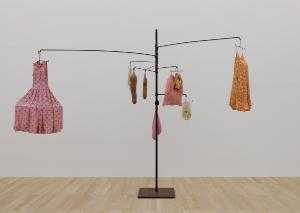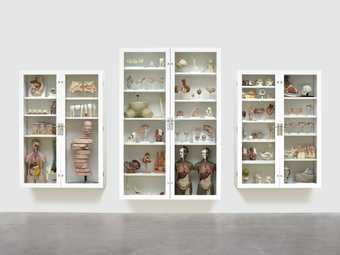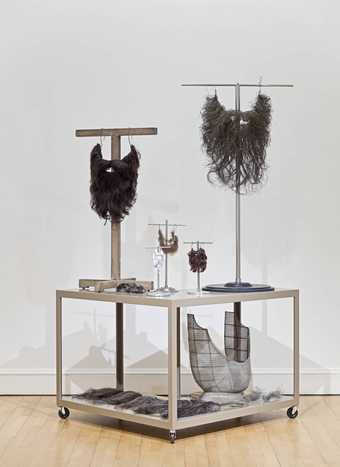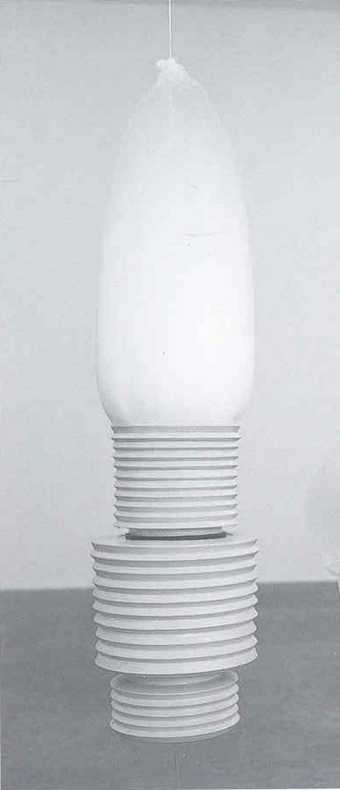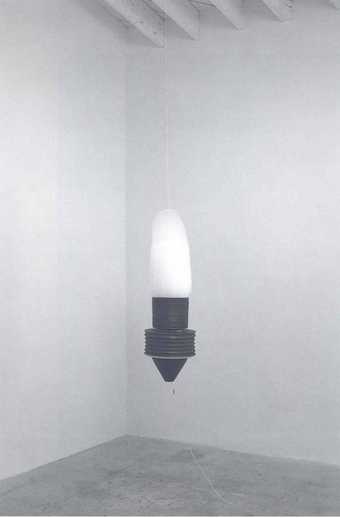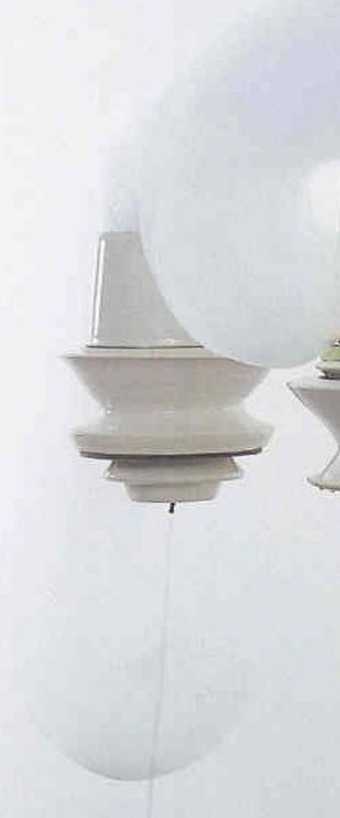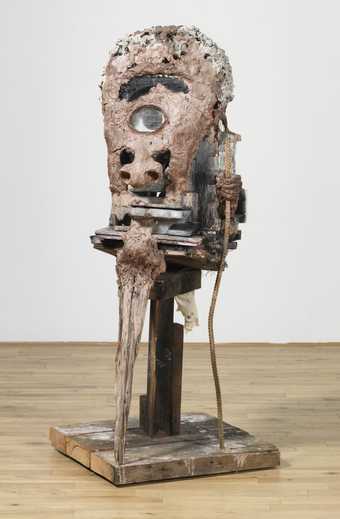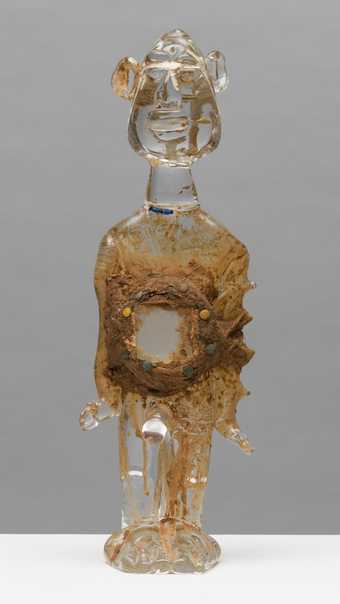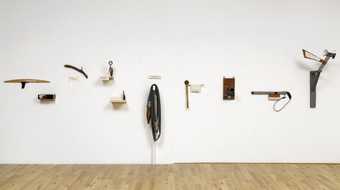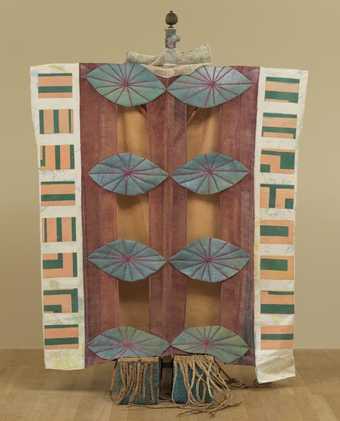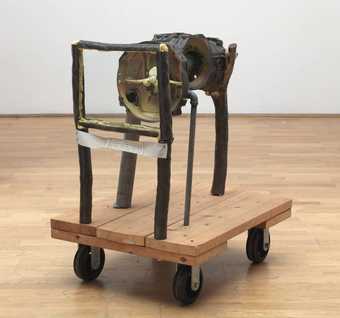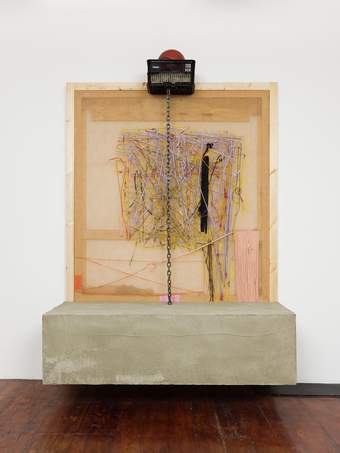Not on display
- Artist
- Jimmie Durham 1940 – 2021
- Medium
- Ibex skull, wooden cot, wooden chair parts, paint, wood, steel, plastic, glass and other materials
- Dimensions
- Object: 1920 × 1600 × 580 mm
- Collection
- Tate
- Acquisition
- Presented by kurimanzutto 2018
- Reference
- T15201
Summary
The sculpture Alpine Ibex 2017 presents an assemblage of found objects in a form that resembles the shape of an ibex (a species of mountain goat) the head of which incorporates a real ibex skull and horns. The artist has painted the bones of the skull with green paint and applied glass eyes into the eye sockets. The head has been fixed to wooden furniture parts and screwed with a piece of metal onto a wooden block, which forms the neck of the animal. The remaining body of the animal is also made of old furniture. The trunk consists of an inverted, slightly conical white lacquered chest, the backrest of a chair stands in for the rear legs, whilst the front legs are made of shorter, old table or chair legs whose ornamentation suggests the jointed legs of the animal.
In 2017 Jimmie Durham created an ongoing series of sculptures entitled Europa that to date includes fourteen works dedicated to the largest European animals. He has commented:
I wanted to gather the skulls of the largest animals of Europe and bring them back into our world by a method which I cannot explain, just as it is impossible to explain most music or poetry. The skulls I worked with all have bodies that are more sculptural than representative. I have the feeling that when using the actual bones, representation of the animal would be too disrespectful to support.
The reasons for attempting such a thing as this are not really knowable. They would also be beside the point, not pertinent nor important.
(Jimmie Durham, ‘Europa’, in Migros Museum für Gegenwartskunst 2017, p.11.)
Besides the Alpine Ibex, the other animals in the Europa series, at the time of writing, are: Bison, Brown Bear, Great Dane, Elk, Eurasian Lynx, Manx Loaghtan, Maremma Bull, Musk Ox, Reindeer, Red Deer, Shire Horse, Wild Boar and Wolf. Each animal has a body composed of different found materials, such as fabrics, furniture or wire, and a real skull for its head. The materials were mostly sourced from flea markets and second-hand stores, but Durham also collects offcuts and rejects from glass studios and furniture workshops in Europe.
An Indian American who lives in Europe, Durham’s project investigates human-animal relations in an attempt to engage contemporary European discourse on animals. Recent contributions to this discussion, such as Bruno Latour’s book Facing Gaia (2017), reject the accepted dichotomy of culture and nature declaring it as outdated. In an essay published in connection with the exhibition of Durham’s project at the Migros Kunstmuseum, Zurich in 2017, curator Richard William Hill described the artist’s position in the discourse as follows:
It is an intervention in that conversation, just as any intellectually valuable perspective would be, but it is not a view from outside. Durham has lived in Europe for decades and grew up in a nation-state created by European settlers. The question[s] his artworks pose … are his participation in a global conversation about how we might better understand the relationship between ourselves and animals. It is, therefore, about the many dichotomies the European tradition has created to categorize and define our relationship to the non-human world.
(Richard William Hill, ‘Nine days living among the very large animals of Europe’, in ibid., p.72.)
Durham creates his own definition of Europe by characterising it through its largest animal inhabitants. Primarily defined in terms of its history, culture and economy, Europe is much less frequently regarded for its wildlife, an anthropocentric view Durham calls into question: ‘It does not matter if another type of animal is not like us in the areas of speech, reasoning, or such criteria, and everyone who has had a pet or friend animal of another species knows this. It is anthropocentric to imagine that we are the standard, that we are angelic, unearthly, or “higher” beings.’ (Jimmie Durham, ‘Europa’, in ibid., p.12.) With the act of creating the animal anew from a human perspective, Durham seeks to break with the predominant idea of the opposition between human and animal. It is for this reason that he uses real skulls: ‘When I work with the skulls, I see very clearly how we really are of the same family, that their skulls are like our skulls, their bodies are like our bodies.’ (Quoted in ibid., p.73.)
Durham first used skulls in 1969, when he was studying in Geneva and saw them as a means of breaking with the lingering intellectual legacy of modernism. In the 1980s he incorporated human and animal bones into his sculptures. Tlunh Datsi 1984 (private collection Belgium), for example, incorporates a puma skull decorated with feathers and mounted on a painted police traffic-barrier; Karankawa 1983 (Collection of Robert Cantor and Margo Levine, New York) is a sculpture that includes a human skull that Durham found on a Texas beach where the Karankawa people had been massacred. These works make direct reference to Durham’s relationship with the American Indigenous culture. In an article from 1993, writer and curator Lucy Lippard explained:
Perhaps the preeminence of skulls and bones in contemporary Indian art is a metaphor both for memory and for the way society sees Native civilization –simultaneously buried and exposed. Idealistically, Jimmie Durham hopes to force the mainstream art audience to confront the fact of a ‘Cherokee art’ that intervenes in their world and, by extension, in the American narrative.
(Lucy Lippard, ‘From the Archives: Jimmie Durham – Postmodernist “Savage”’, Art in America, 1 February 1993, http://www.artinamericamagazine.com/news-features/magazine/from-the-archives-jimmie-durham-postmodernist-savage/, accessed 20 December 2017.)
Although at a first glance closely linked to this narrative, Durham’s Europa series takes a deliberately European stance and thus is set slightly apart from his involvement with Indigenous art and culture. Nevertheless works such as Alpine Ibex are characteristic of his practice both formally and in terms of his engagement with socio-political and critical discourse.
Further reading
Waiting to be Interrupted, Selected Writings 1993–2012, Jimmie Durham, Milan 2014.
Jimmie Durham. God’s Children, God’s Poems, exhibition catalogue, Migros Museum für Gegenwartskunst Zürich, 26 August–5 November 2017.
Jimmie Durham: At the Center of the World , exhibition catalogue, Hammer Museum, Los Angeles, 29 January–7 May 2017, Walker Art Center, Minneapolis, 22 June–8 October 2017, Whitney Museum of American Art, New York, 3 November 2017–28 January 2018, Remai Modern, Saskatoon 23 March–12 August 2018.
Monika Bayer-Wermuth
December 2017
Does this text contain inaccurate information or language that you feel we should improve or change? We would like to hear from you.
Display caption
‘I wanted to gather the skulls of the largest animals of Europe and bring them back into our world’, Durham has said, describing the resulting works as ‘animal spirits’. This assemblage of found objects incorporates the skull and horns of an ibex, a wild mountain goat found in the Alps. For Durham, the work is ‘more sculptural than representative’
No animal was harmed for the purpose of creating this sculpture. The skull and horns were acquired from a licensed dealer, who only uses materials that arise as a by-product of food production or natural causes, and never from endangered or protected species.
Gallery label, December 2020
Does this text contain inaccurate information or language that you feel we should improve or change? We would like to hear from you.
You might like
-
Louise Bourgeois Untitled
1996 -
Damien Hirst Trinity - Pharmacology, Physiology, Pathology
2000 -
Robert Therrien No Title (Beard Cart)
2004 -
Roger Hiorns Untitled
2003 -
Roger Hiorns Untitled
2005 -
Roger Hiorns Untitled
2005 -
Roger Hiorns Untitled
2005 -
Tamás Kaszás Shanty Tower
2014 -
Huma Bhabha Man of No Importance
2006 -
Pascale Marthine Tayou Poupée Pascale #09
2014 -
Jimmie Durham Untitled
1993–2012 -
Tamara Henderson Road to Recovery
2016 -
Alvaro Barrington Street Dreams are Made of Basketball
2021 -
Helen Marten The Age in Which We Love (Bulging the House)
2021


